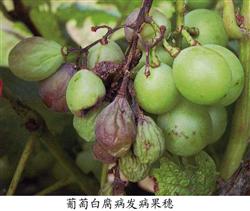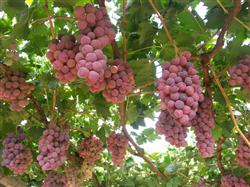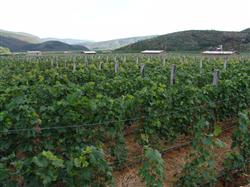How to control diseases in summer when planting grapes?

Grape white rot grape downy mildew planting grape summer how to control the disease? Please give guidance to the method that there is more rainfall in summer and grape is prone to disease in a large area. Therefore, for grape growers, special attention should be paid to disease control in summer, especially black pox, white rot, anthrax and downy mildew. First, give priority to prevention and spray in time. For drugs with a residual period of 17 to 21 days, they are generally sprayed every 15 days. If it rains in the middle, depending on the rainfall, shorten the next spraying days as appropriate. If there is heavy rain after spraying, it will be sprayed again after it clears up. If the adjacent two kinds of drugs are alkaline or acidic respectively, we should pay strict attention to the interval time to prevent the two kinds of acid and alkali from neutralizing. Second, when you see the initial onset of the disease, treat it in time. Grapes are most susceptible to disease when it is overcast and rainy, hot and humid, so make a comprehensive observation in the vineyard once a day. Spray symptomatic medicine at the beginning of the disease. For the prevention and control of downy mildew, 70% Kobo 600x solution, 80% ethyl aluminum 300x solution or 1 ∶ 0.7∶ Bordeaux solution can be used for the control of downy mildew. Third, Bordeaux liquid is the main solution, suitable for other drugs. In the process of grape disease prevention, Bordeaux liquid should be used to adapt to other drugs, and the disease control effect is better. It can spray 1 ∶ 0.5 ∶ 240x before flowering, 1 ∶ 0.7 ∶ 220x after anthesis, 1 ∶ 0.7∶ 200x during the expansion period of grapes, 1 ∶ 1 ∶ 180x after harvest, and 1 ∶ 1 ∶ 160x twice in autumn. If diseases such as white rot and anthrax occur in the middle, they can be sprayed symptomatically, but most of the drugs for the prevention and treatment of these diseases are acidic, and the products must be tried out in a small area before being used in a large area. Fifth, loosen the soil in time to increase soil permeability. In rainy season, especially after heavy rain and heavy rain, the surface of the vineyard will be hardened and the soil will be poorly ventilated, resulting in lack of oxygen in grape roots, weakening of tree potential, reduced resistance and susceptibility to disease. Therefore, the soil should be ploughed before the rainy season. In the rainy season, we should seize the time between rainless days and plough the vineyard to increase the permeability of the soil. Sixth, clean the auxiliary tip to facilitate ventilation and light transmission. In rainy season, grapes are most likely to grow, and the incidence of secondary shoots is very high. It is necessary to pick the heart of the grapes and wipe off the secondary tips in time. At the same time, some of the plants with too many new shoots should be removed. Seventh, clear the garden at the right time to curb the spread of the disease. The hot and humid environment is conducive to the spread of germs, so it is necessary to clear the garden at any time, remove the diseased leaves, branches and fruits from the garden, bury them deeply or burn them. At the same time, get rid of weeds in the garden in time. Click to get more grape planting techniques click to get more fruit planting techniques
- Prev

How to control diseases of red grape in summer?
How to control diseases of red grape in summer? Please give guidance to summer red grapes can refer to the following methods to control diseases: 1. Clear the garden: if there is a disease in the vineyard and there is a lot of rain at this time, clear the garden at any time and remove the diseased leaves, branches and fruits from the garden. Deep burial or burning. At the same time, clean up in time.
- Next

What do summer grapes need to pay attention to?
What do summer grapes need to pay attention to? Please introduce the following points that should be paid attention to in summer grapes: first, prevention of drug damage: the causes of drug damage are improper dispensing methods, excessive concentration, spraying herbicides around noon in hot weather, etc., characterized by tender shoots, young leaves in the shape of chicken claws or small paper umbrellas.
Related
- Moge, come on! The staff of the peasant association in the producing area of cantaloupe were frightened when the crowd gathered.
- Causes and Solutions of low Fruit setting rate of Apple
- Symptoms and control measures of passion fruit virus disease
- Fruit growing lesson: how do apple orchards keep high yields?
- Can you build orchards in the mountains? What are the pros and cons?
- How to manage the coloring period of Crisson grape?
- This paper introduces the processing technology of two kinds of fig products.
- How much is a month for retired teachers in rural areas by 2020?
- How can strawberry planting increase sugar content? We should pay attention to management in many aspects.
- What are the cultivation techniques on how to improve the yield of golden fruit?

